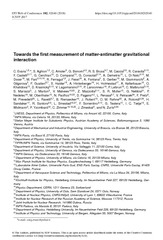Towards the first measurement of matter-antimatter gravitational interaction
Evans, Craig; Aghion, Stefano; Amsler, Claude; Bonomi, Germano; Brusa, Roberto Sennen; Caccia, Massimo; Caravita, Ruggero; Castelli, Fabrizio; Cerchiari, Giovanni; Comparât, Daniel; Consolati, Giovanni; Demetrio, Andrea; di Noto, Lea; Doser, Michael; Fanì, Mattia; Ferragut, Rafael; Fesel, Julian; Fontana, Andrea; Gerber, Sebastian; Giammarchi, Marco G.; Gligorova, Angela; Guatieri, Francesco; Haider, Stefan; Hinterberger, Alexander; Holmestad, Helga Margrete; Kellerbauer, Alban; Khalidova, Olga; Krasnický, Daniel; Lagomarsino, Vittorio; Lansonneur, Pierre; Lebrun, Patrice; Malbrunot, Chloé; Mariazzi, Sebastiano; Marton, Johann; Matveev, Viktor A.; Mazzotta, Zeudi; Müller, Simon R.; Nebbia, Giancarlo; Nédélec, Patrick; Oberthaler, Markus K.; Pacifico, Nicola; Pagano, Davide; Penasa, Luca; Petráček, Vojtěch; Prelz, Francesco; Prevedelli, Marco; Ravelli, Luca; Rienaecker, Benjamin; Robert, Jacques C.; Røhne, Ole Myren; Rotondi, Alberto; Sandaker, Heidi; Santoro, Romualdo; Smestad, Lillian; Sorrentino, Fiodor; Testera, Gemma; Tietje, Ingemari C.; Widmann, Eberhard; Yzombard, Pauline; Zimmer, Christian; Zmeskal, Johannes; Zurlo, Nicola
Peer reviewed, Journal article
Published version

Åpne
Permanent lenke
https://hdl.handle.net/1956/20598Utgivelsesdato
2018Metadata
Vis full innførselSamlinger
Originalversjon
https://doi.org/10.1051/epjconf/201818202040Sammendrag
The AEgIS (Antimatter Experiment: Gravity, Interferometry, Spectroscopy) is a CERN based experiment with the central aim to measure directly the gravitational acceleration of antihydrogen. Antihydrogen atoms will be produced via charge exchange reactions which will consist of Rydberg-excited positronium atoms sent to cooled antiprotons within an electromagnetic trap. The resulting Rydberg antihydrogen atoms will then be horizontally accelerated by an electric field gradient (Stark effect), they will then pass through a moiré deflectometer. The vertical deflection caused by the Earth's gravitational field will test for the first time the Weak Equivalence Principle for antimatter. Detection will be undertaken via a position sensitive detector. Around 103 antihydrogen atoms are needed for the gravitational measurement to be completed. The present status, current achievements and results will be presented, with special attention toward the laser excitation of positronium (Ps) to the n=3 state and the production of Ps atoms in the transmission geometry.
